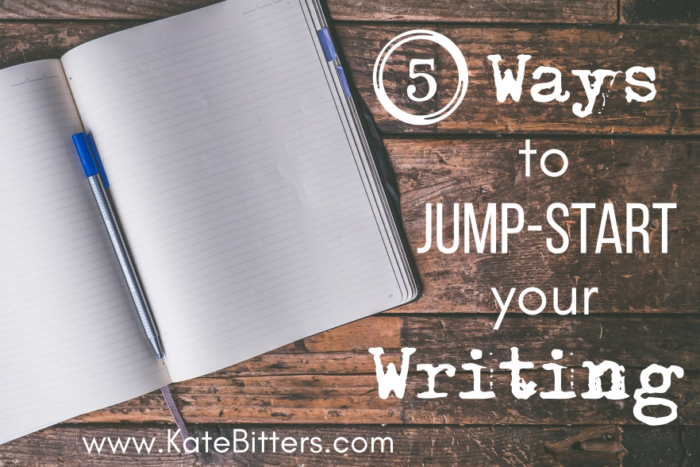Beginnings are terrifying because there’s all that blankness in front of you. You’re staring up at the gigantic mountain you’d like to climb, knowing you’ve taken zero steps so far. You’re at the point in your writing journey where you haven’t yet left the Shire. You haven’t flown away from Tatooine. You’re still packing your bags for solo-hiking the Pacific Crest Trail.
How do you get over your (potentially paralyzing) trepidation?
You might not exactly “get over it,” but you can work through it. And once you work through your fear of getting started, things get less scary. I promise. It the same as staring down any major task in your life. If you’d like to get in shape, you have to start by putting on your tennis shoes. If you want to deep-clean your basement, you have to steel your nerves and step down into the clutter. If you want to climb that mountain I mentioned earlier, you have to gear up and take your first step. Then another. Then another.
I won’t pretend to have all the answers for working through your fear of beginnings, but I will offer a few useful nuggets that have worked for me and/or have worked for other writers. Here are 5:
1. Practice First
Before diving into writing your novel, it’s a good idea to practice. Even if you’re an experienced writer, I highly recommend doing some free writing before you begin. What does this achieve?

Free writing is like stretching before a workout. It loosens your writing muscles and gets language flowing through your head. It is very, very difficult to sit down and start writing when you haven’t had a proper warm-up. If you haven’t written in a while, try engaging in a couple weeks-worth of free writing before you begin your project. Set aside 15 or 20 minutes every morning and just write.
You could write content related to your yet-to-be-written novel OR you could write about whatever pops into your head. If you’d like a little direction, try using writing prompts. Here’s are a list of 88 prompts to get started.
Free writing is like stretching. It loosens your writing muscles and gets language flowing. Click To Tweet2. Take It a Word at a Time
Anne Lamott is known for (among other acclaimed works) Bird By Bird, a book on writing advice. In that book, she talks about a time when her brother neglected to start a school project until the night before it was due—a project about birds. Sitting tearfully at the kitchen table, all his research books spread in front of him, her brother bemoaned the momentous task in front of him.
Anne’s father responded to his forlorn son by saying, just take it bird by bird.
The moral of the story is that this advice also applies to writing. You might have an enormous task in front of you, but it’s best to not think about that. Take your writing one sentence, one word at a time. Start at the beginning and keep chipping away until you’ve said all you set out to say.
Before I wrote my first novel, Elmer Left, I had never written anything longer than about 20 pages. I had plenty of false starts and failed attempts at books, but had never come close to finishing any of them. With Elmer Left, I kept going. I surpassed the 20-page mark, the 50-page mark. I wrote and wrote until I had the first draft of a 450-page novel.
When I started this writing adventure, I didn’t know how long the book would be. I had a collection of ideas, a rough outline, and the tenacity to keep going. One word at a time.

3. Set Goals
Listen. Goal-setting is not some fluffy thing you’re made to do at work. It’s a tactic that actually works. Without concrete goals, you’re likely to flounder.
“But all my goals fail!” You might say.
“Welp,” I reply. “That’s because you’re doing it wrong.”
Many people pick a goal out of thin air and say, “That’s my goal. Ready, set, go!” The problem with that method is that such careless goal-setting doesn’t have any teeth. It’s like pointing at any old car in an auction lot and saying, “I’ll take it! Here’s hoping it runs…”
INSTEAD, TRY THIS APPROACH:
1. Identify your ultimate goal and when you’d like it accomplished (for example: writing the first draft of a novel within eight months).
2. Break the goal into bite-sized pieces (“I’d like to ultimately write 80,000 words, so I’m going to aim to write 10,000 words per month”).
3. Make a plan for HOW you’ll accomplish your bite-sized goals
STEP NUMBER 3 IS ACTUALLY THE MOST IMPORTANT. CHALLENGE YOURSELF TO ASK “HOW” UNTIL YOU’VE HAMMERED OUT A CONCRETE PLAN.
Q: How will you write 10,000 words per month?
A: I’ll commit to writing about 500 words per day, with weekends off.
Q: How will you do that?
A: I’ll get up every morning and write for an hour.
Q: How?
A: I’ll set an alarm and I’ll make sure to honor it.
Q: I will tell my significant other my plans. I’ll also pledge to go without any TV until I get my hour of writing in.
Now we’re getting somewhere…
Part of goal-setting may involve rewards (treat yourself to a nice dinner at each 10,000-word mark) and punishments (no dessert until you hit your word count goal). You may also be motivated by peer pressure (join a writing group for the ultimate peer pressure) or an accountability partner. Figure out what motivates you, and make it part of your goal setting.
4. Don’t Over-Plan
I’m a big proponent of outlining, but I also know that outlining can paralyze you. If, for instance, you’re writing a fantasy novel, you may be tempted to build your world to death (designing the language, the geography, the cultural, every holiday and superstition, every item of food…etc., etc., etc.). If you’re writing a book that involves a lot of research, you may read book after book and never actually get started on your own book.
I recommend creating an outline, but not letting yourself get bogged down by the details. You will run into knowledge gaps as you write your book. You can also make a note in the margin to “research and fill in later.” Then, move on. Keep writing. Don’t get hung up on the things you don’t know. Let the book unravel beneath your fingers.
5. Understand Your First Draft’s Purpose
WHAT IS THE PURPOSE OF A FIRST DRAFT?
1) To give your book a shape
2) To reveal what you don’t know
3) To provide a springboard for your edits
It is not the be all, end all. It will likely end up far away from perfect. And that’s okay. Most of your writing will be rewriting.
Knowing that your first draft can and will be revised should alleviate some of the pressure of starting your first few pages. Take a deep breath, put your pen to paper or fingers on your keyboard, and understand that nothing you write has to be permanent.
But (as LeVar Burton always said), don’t take my word for it. Listen to what some of the greatest writers of all time have to say:
“The first draft of anything is sh*t.” – Ernest Hemingway
“Get it down. Take chances. It may be bad, but it’s the only way you can do anything really good.” -William Faulkner
“A good book isn’t written, it’s rewritten.” – Phyllis A. Whitney
Still feeling nervous about writing your first few pages? That’s normal, and that fear will likely never completely go away (it hasn’t for me). Despite the fear, I encourage you to plow ahead anyway, because you never know what wonders will emerge from your writing.
Don’t you want to find out?

Author: KateBitters
Kate Bitters is a Minneapolis-based author and freelance writer. She is the author of Elmer Left, Ten Thousand Lines, and He Found Me. One of her proudest/nerdiest moments was when Neil Gaiman read one of her short stories on stage at the Fitzgerald Theater.

Kate,
These are excellent suggestions. I’ve done all but one of them. I love outlining but I’ve been forging ahead without doing it, although, I seem to be doing a lot of outlining in my head when I wake up in the morning. That’s when my chapters appear to me; that’s how my segue ideas appear; and that’s how my characters grow. I usually remember most of those thoughts even though it all seems a bit sketchy when I sit down to write.
‘I’m terribly slow at this but I believe it’s fear-based procrastination.
Auntie Ana